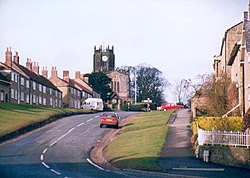Coxwold
| Coxwold | |
| Yorkshire North Riding | |
|---|---|
 Coxwold and St Michael's Church | |
| Location | |
| Grid reference: | SE534771 |
| Location: | 54°11’17"N, 1°10’55"W |
| Data | |
| Population: | 259 (2011) |
| Post town: | York |
| Postcode: | YO61 |
| Dialling code: | 01347 |
| Local Government | |
| Council: | North Yorkshire |
| Parliamentary constituency: |
Thirsk and Malton |
Coxwold is a village in the North Riding of Yorkshire, on the North York Moors (within the bounds of the National Park). The village is 18 miles north of York.
It is here that the Rev. Laurence Sterne wrote his work A Sentimental Journey Through France and Italy.
Most of the buildings in the village are on a slight incline, climbuing up to a summit where stands the church. At the bottom of the hill was the village smithy, now a holiday cottage. The Fauconberg Arms Inn is on the main street.
Green's Beck runs south-westwards through the village to join Mill Beck, form Elphin Beck and eventually flow into the River Swale.
History
The village name is believed to be derived from Old Englis words Cuc weald, meaning cry wood.[1]
The village is mentioned in Domesday Book of 1086 by the name of Cucvalt. The lord of the manor at the time of the Norman invasion was Kofse but the manor passed to Hugh, son of Baldric,[2] and thence to Roger de Mowbray. Before 1158 the manor and lands of Coxwold passed to Thomas de Colville. In return for the lands Thomas had to swear allegiance to Roger de Mowbray. Thomas de Colville's estate included the manors of Yearsley, Coxwold and Oulston as well as other properties and land in York, Thirsk, Everley, Nunwick, Kilburn and Upsland. The Colville shield is displayed at one of the roof intersections in the twelfth-century Norman church in Coxwold.[3]
Successive generations of Colvilles held the estate and lands of Coxwold until 1405 when the eighth Thomas Colville was murdered, probably on the instructions of Richard le Scrope, Archbishop of York, who, in turn, was acting on behalf of Henry Percy, 1st Earl of Northumberland. The bulk of the Coxwold estate was then granted to the Uhtred-Neville family.[3]
While in possession of the Coxwold estate the Colville family made generous grants to Byland Abbey and Newburgh Priory but at the turn of the fourteenth century there were disputes between the monks of Newburgh Priory and the Colvilles over rights to land around Coxwold.[3]
In 1304 the fifth Sir Thomas Colville started a tradition of a weekly market to be held in the grounds of the manor of Coxwold. He also established a two-day annual fair to celebrate the Assumption, a tradition that survived uninterrupted in Coxwold Manor for some five hundred years.[3]
The seventh Sir Thomas Colville (of Yearsley and Coxwold) became famous following a jousting incident before the Battle of Crécy in 1346 when he crossed the river to joust with a French knight who had been hurling abuse at the English king. He later joined the retinue of John of Gaunt, the Duke of Lancaster, and by far the richest noble in England.[3]
At one time the village had a station on the Thirsk and Malton Line. It opened on 19 May 1853 but closed on 7 August 1964 as part of the reorganisation of the national railway system.[1][4]
Parish church
Since 700 AD Coxwold has had a church at the top of the hill. The present church was built in 1420 in the Perpendicular style with an unusual octagonal west tower and is dedicated to St Michael. The chancel features a unique tongue-shaped communion rail (early 18th century). Laurence Sterne was appointed vicar in 1760.[5]
About the village
To the south of the village is Newburgh Priory, a Grade I listed[6] stately home built on the site of a former Augustinian priory. The original priory was built in 1145 by Roger De Mowbray but fell victim to the Dissolution of the Monasteries under King Henry VIII. The King sold the estate to Anthony de Bellasis, whose family took the name of Fauconberg when the baronetcy was created. The estate passed to the Wombwell family in 1825 at the end of the male line and remains in their possession today.
To the north of the village are the ruins of Byland Abbey, a Grade I listed structure.[7] The Abbey was founded in the 12th century by Savigniac monks.[8]
Outside links
| ("Wikimedia Commons" has material about Coxwold) |
References
- ↑ 1.0 1.1 Bulmer's Topography, History and Directory (Private and Commercial) of North Yorkshire 1890. S&N Publishing. 1890. pp. 669, 670. ISBN 1-86150-299-0.
- ↑ Coxwold in the Domesday Book
- ↑ 3.0 3.1 3.2 3.3 3.4 Yearsley: A Genealogical Story Part 1: The Early Years
- ↑ "History". http://www.coxwoldvillage.co.uk/. Retrieved 1 December 2012.
- ↑ Nikolaus Pevsner: The Buildings of England: Yorkshire: The North Riding, 1966 Penguin Books ISBN 978-0-300-09665-1
- ↑ National Heritage List 1150725: Newburgh Priory (Grade I listing)
- ↑ National Heritage List 1315790: Byland Abbey (Grade I listing)
- ↑ "Abbey". http://www.english-heritage.org.uk/daysout/properties/byland-abbey/history-and-research/history/. Retrieved 1 December 2012.
